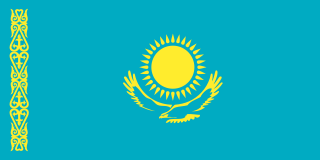
Kazakhstan, officially the Republic of Kazakhstan, is a landlocked country primarily in Central Asia, with a small portion of its territory in Eastern Europe. It borders Russia to the north and west, China to the east, Kyrgyzstan to the southeast, Uzbekistan to the south, and Turkmenistan to the southwest, with a coastline along the Caspian Sea. Its capital is Astana, while the largest city and leading cultural and commercial hub is Almaty. Kazakhstan is the world's ninth-largest country by land area and the largest landlocked country. It has a population of 20 million and one of the lowest population densities in the world, at fewer than 6 people per square kilometre. Ethnic Kazakhs constitute a majority, while ethnic Russians form a significant minority. Officially secular, Kazakhstan is a Muslim-majority country with a sizeable Christian community.

The demographics of Kazakhstan enumerate the demographic features of the population of Kazakhstan, including population growth, population density, ethnicity, education level, health, economic status, religious affiliations, and other aspects of the population. Some use the word Kazakh to refer to the Kazakh ethnic group and language and Kazakhstani to refer to Kazakhstan and its citizens regardless of ethnicity, but it is common to use Kazakh in both senses. It is expected that by 2050, the population will range from 23.5 to 27.7 million people.

Kazakh or Qazaq is a Turkic language of the Kipchak branch spoken in Central Asia by Kazakhs. It is closely related to Nogai, Kyrgyz and Karakalpak. It is the official language of Kazakhstan, and has official status in the Altai Republic of Russia. It is also a significant minority language in the Ili Kazakh Autonomous Prefecture in Xinjiang, China, and in the Bayan-Ölgii Province of western Mongolia. The language is also spoken by many ethnic Kazakhs throughout the former Soviet Union, Germany, and Turkey.

Kokshetau, formerly known as Kokchetav between 1868 and 1993, is a lakeside city in northern Kazakhstan and the capital of Akmola Region. It stretches along the southern shore of Lake Kopa, lying in the north of Kokshetau Hills, a northern subsystem of the Kokshetau Uplands (Saryarka) and the southern edge of the Ishim Steppe. It is named after Mount Kokshe.

Atyrau Region formerly known as Guryev Region until 1991, is one of the regions of Kazakhstan, in the west of the country around the northeast of the Caspian Sea. Its capital is the city of Atyrau, with a population of 355,117; the region itself has a population of 681,241, of which Kazakhs make up more than 90%.

This article details the geographical distribution of Russian-speakers. After the dissolution of the Soviet Union in 1991, the status of the Russian language often became a matter of controversy. Some Post-Soviet states adopted policies of derussification aimed at reversing former trends of Russification, while Belarus under Alexander Lukashenko and the Russian Federation under Vladimir Putin reintroduced Russification policies in the 1990s and 2000s, respectively.

North Kazakhstan Region is a region of Kazakhstan, with a population of 539,111. Its capital is Petropavl, with a population of 193,300 people.

Pavlodar Region is a region of Kazakhstan. The population of the region was 742,475 ; and 806,983. The latest official estimate was 756,511. Its capital is the city of Pavlodar, which had a population of 360,014 at the start of 2018. Many people, especially Ukrainians, migrated to Pavlodar in Nikita Khrushchev's Virgin Lands Campaign.

Jambyl or Zhambyl Region, formerly known as Dzhambul Region until 1991, is a region of Kazakhstan. Its capital is Taraz. The population of the region is 1,209,665; the city is 335,100. The region borders Kyrgyzstan, and is very near to Uzbekistan. Jambyl also borders three other provinces: Karaganda Region, Turkistan Region and Almaty Region. The total area is 144,200 square kilometres (55,700 sq mi). The province borders Lake Balkhash to its northeast. The province was named after the Kazakh akyn Jambyl Jabayev.

There has been a substantial population of Russian Kazakhstanis, or simply Russian Kazakhs, which are ethnic Russians living in Kazakhstan as their citizen, since the 19th century. Although their numbers have been reduced since the breakup of the Soviet Union, they remain prominent in Kazakh society today. Russians formed a plurality of the Kazakh SSR's population for several decades.

Christianity in Kazakhstan is the second most practiced religion after Islam and one of the major religions of Kazakhstan.

Mangystau Region, formerly known as Mangyshlak Region from 1973 until 1988, is a region of Kazakhstan. Its capital is Aqtau, which has a population of 183,350 (2017); the entire Mangystau Province has a population of 745,909 (2022).

Karaganda Region is a region of Kazakhstan. Its capital is Karaganda.

Qyzylorda Region, formerly known as Kyzyl-Orda Region until 1991, is a region of Kazakhstan. Its capital is the city of Qyzylorda, with a population of 234,736. The region itself has a population of 823,251. Other notable settlements include Aral, Kazaly (Kazalinsk) and the Russian-administered Baikonur, which services the Baikonur Cosmodrome. The total area of the province is 226,000 square kilometers (87,000 sq mi).

The Bolashak Programme is a scholarship which is awarded to high-performing students from Kazakhstan to study overseas all-expenses paid, provided that they return to Kazakhstan to work for at least five years after graduation.
According to various polls, the majority of Kazakhstan's citizens, primarily ethnic Kazakhs, identify as Sunni Muslims.

The following outline is provided as an overview of and topical guide to Kazakhstan:

Kazakhstan–Russia relations are the bilateral foreign relations between Kazakhstan and the Russian Federation. Kazakhstan has an embassy in Moscow, a consulate-general in Saint Petersburg, Astrakhan, and Omsk. Russia has an embassy in Astana and consulates in Almaty and Oral.

Kazakhstan is a multiethnic country where the indigenous ethnic group, the Kazakhs, comprise the majority of the population. As of 2024, ethnic Kazakhs are about 71% of the population and ethnic Russians in Kazakhstan in 2024 was about 14.9% in second place. These are the two dominant ethnic groups in the country with a wide array of other groups represented, including Ukrainians, Uzbeks, Germans, Tatars, Chechens, Ingush, Uyghurs, Koreans, and Meskhetian Turks.

Shymkent is a city in Kazakhstan, near the border with Uzbekistan. It is one of three cities in Kazakhstan that have the status of a city of republican significance. It is the third-most populous city in Kazakhstan, behind Almaty and Astana, with an estimated population of 1,002,291 as of 1 June 2018. It is a regional cultural centre. Shymkent is situated 690 kilometres (430 mi) west of Almaty and 1,483 kilometres (920 mi) south of Astana. It is also 120 kilometres (75 mi) to the north of Tashkent, Uzbekistan.






















